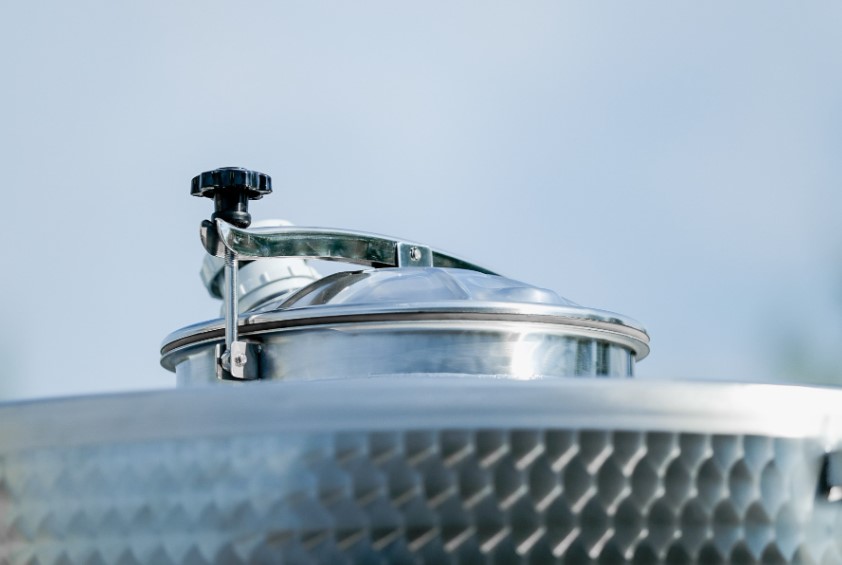Exploring Winemaking – the Impact of Fermentation Vessels on Taste
Table of Contents
The art of winemaking is an intricate dance between tradition and innovation, where every decision, no matter how small, can influence the taste and character of the final product. Among these decisions, the choice of fermentation vessel stands out as a pivotal factor. Whether it’s the classic wooden barrels, the modern stainless steel wine tanks, the ancient clay amphorae, or the trendy concrete eggs, each vessel imparts its unique touch to the evolving wine. In this exploration, we delve into the world of fermentation vessels to unravel the intricacies of how they shape the wines we savor.

From Grapes to Wine – the Ancient Alchemy
At its core, wine is a product of nature’s alchemy, where freshly gathered grapes undergo the magical transformation of fermentation. This natural process, discovered by Neolithic humans thousands of years ago, turns grape juice into wine. However, without intervention, fermentation would continue unabated, eventually leading to oxidation and vinegar. Modern winemaking steps in to harness this natural phenomenon, guiding the grape juice’s journey from its simple form to the intricate complexity of wine. Control becomes paramount, ensuring consistency and reliability while allowing the wine’s unique character to shine through.
Choosing the Right Fermentation Vessel
Winemakers, armed with a deep understanding of grape varieties, traditions, desired wine styles, budget constraints, and an inherent curiosity, face a myriad of choices. One such crucial decision lies in the selection of the fermentation vessel. The vessel becomes the canvas upon which the winemaker paints the wine’s narrative. Each option, whether a centuries-old tradition or a contemporary trend, brings forth a distinctive set of characteristics. Wooden barrels, with their rich history, impart subtle flavors; stainless steel tanks offer pristine conditions; clay amphorae harken back to ancient practices, and concrete eggs provide a modern twist.
Balancing Tradition and Innovation – Pros and Cons of Fermentation Vessels
As winemakers weigh their options, they navigate a delicate balance between honoring age-old traditions and embracing innovative techniques. Each vessel comes with its pros and cons, influencing not only the taste but also the texture, aroma, and aging potential of the wine. In this exploration, we will delve into these nuances, uncovering the secrets behind the winemaker’s choice and understanding how this decision resonates in the glass.
Stainless Steel – the Technological Marvel in Winemaking
In the realm of modern winemaking, one innovation stands out as a true game-changer: stainless steel. Originally borrowed from the dairy industry in the 1960s, stainless steel has become an indispensable component in wineries worldwide, revolutionizing the way wines are crafted.
The Practical Brilliance of Stainless Steel
Despite its initial high cost, stainless steel proves its worth with its unmatched qualities. It boasts robustness, ensuring longevity and durability in the winemaking process. Its hygienic nature and ease of cleaning make it a preferred choice for winemakers aiming for pristine conditions. Moreover, stainless steel offers excellent thermal transfer capabilities, allowing rapid adjustments in temperature. Thanks to modern technology, these vats are now intricately controlled by computers and often equipped with cooling jackets and internal panels, ensuring precise temperature regulation throughout the winemaking process.
Preserving Purity – Stainless Steel’s Oxygen-Proof Seal
One of the standout features of stainless steel is its imperviousness to oxygen. This characteristic enables winemakers to maintain a tightly sealed environment, crucial for preserving the wine’s delicate aromas and flavors. Inert gases like nitrogen can be used to shield the wine from exposure to air, ensuring that the final product encapsulates the pure essence of the fruit. Winemakers utilize stainless steel tanks to cultivate clean flavors and the pristine purity of fruit. Through this meticulous process, the essence of the vineyard is captured and bottled, allowing wine enthusiasts to savor the very spirit of the terroir.
